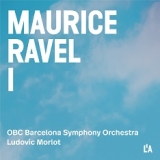Das Symphonieorchester Barcelona (OBC) und sein Musikdirektor Ludovic Morlot wollen zwischen April 2024 und Dezember 2026 das gesamte Orchesterwerk mit den beiden Opern von Maurice Ravel auf sechs CDs veröffentlichen. Es handelt sich um eine langfristige Zusammenarbeit zwischen OBC und Ravel Edition, d.h. die Werke werden mit den revidierten Ausgaben aufgenommen. Das erste Album liegt nun vor und legt gleich die Messlatte hoch.
Das Programm beginnt mit einer ungemein frischen und farbigen Aufnahme von Le Tombeau de Couperin. Diese Komposition zeichnet sich durch zwei bahnbrechende Neuerungen aus – die Emanzipation der Klangfarbe als eigenständiges musikalisches Element und die Wiederaneignung alter Formen. Und bei Morlot wird das ‘Grab’ alles andere als ehrwürdig oder modrig. Er schafft in einem klaren, hellen und sehr präsenten Klangbild eine wunderbar lebendige Interpretation, eine der schönsten, die ich kenne.
Morlot dirigiert Ma mère l’oye sehr stimmungsvoll und märchenhaft, aber auch effektvoll. Hervorzuheben sind die kristalline Reinheit des Orchesterklangs sowie die rhythmische Präzision.
Eine sensibel dirigierte und brillant gespielte Pavane beendet dieses erste Ravel-Programm aus Barcelona. Wir sind gespannt auf die Fortsetzung.
Between April 2024 and December 2026, the Barcelona Symphony Orchestra (OBC) and its music director Ludovic Morlot plan to release the complete orchestral works of Maurice Ravel as well as his two operas on six CDs. This is a long-term collaboration between the OBC and Ravel Edition, which means that the works will be recorded using the revised editions. The first album is now available and immediately sets the bar high.
It begins with an exceptionally fresh and colorful recording of Le Tombeau de Couperin. This composition features two groundbreaking innovations – the emancipation of timbre as an independent musical element and the reappropriation of ancient forms. And for Morlot, the tombeau, the ‘grave’ is anything but venerable or musty. With a clear, bright and very present sound, he creates a wonderfully lively interpretation, one of the most beautiful I have ever heard.
Morlot conducts Ma mère l’oye in a very atmospheric and fairy-tale manner, but also to great effect. The crystalline purity of the orchestral sound and the rhythmic precision should be emphasized.
A sensitively conducted and brilliantly played Pavane concludes this first Ravel program from Barcelona. We look forward to the sequel.
























